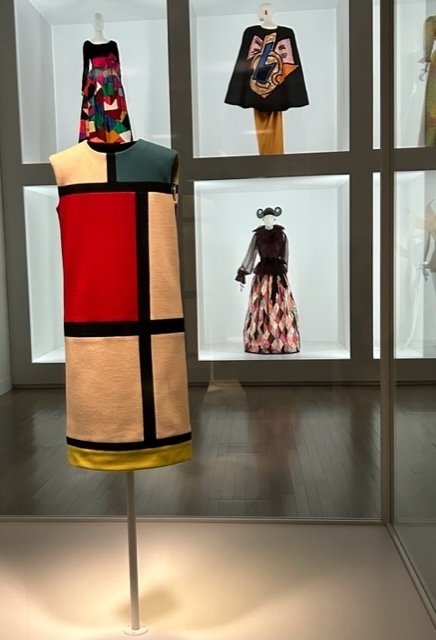
Yves Saint Laurent Exhibition - Beyond Time Style
<This article was originally written by Kaori Nakano in Japanese for Japan Business Press autograph, 13/October/2023>
The "Yves Saint Laurent Exhibition - Beyond Time Style" is currently being held at the National Art Center, Tokyo. It marks the first major retrospective exhibition in Japan since Yves Saint Laurent's passing. The exhibition offers a comprehensive view of Yves Saint Laurent's 40-year history, showcasing 262 pieces, including 110 full ensembles.
The exhibition is organized into 12 chapters, encompassing iconic works, imaginary journeys, bridal collections, stage art, and his connection with Japan. It allows viewers to revisit Yves Saint Laurent's accomplishments from various perspectives, such as his contribution to universal women's style that endures to this day, his global engagement through fashion, his role in driving social change through clothing, and his interaction with Japanese culture during the period of high economic growth.
While detailed highlights for each chapter are available on the exhibition's official website, I'd like to emphasize one section, particularly intriguing to fashion history enthusiasts. Chapter 5, "History of Fashion," offers a fascinating exploration of Yves Saint Laurent's interpretation of fashion history. Sixteen ensembles spanning from ancient Greece to the 1940s are presented. Yves Saint Laurent skillfully reconstructed the essential features of each era and breathed new life into them, making them relevant and fresh to contemporary sensibilities, specifically during the 1970s to 1990s.
His innovative approach revitalized elements such as the asymmetric draping from ancient Greece, the pagoda sleeves of the Middle Ages, the panniers of the Rococo period, the bustle of the late 19th century, and the flapper style of the 1920s. The daring transformation of the bustle into a miniskirt is especially noteworthy. One can't help but imagine how confident 19th-century ladies wearing the bold, hip-emphasizing bustles would feel in the 1990s. Yves Saint Laurent not only paid homage to fashion history but also masterfully incorporated it into his unique stylistic world, transcending the confines of nostalgia. His vision, steeped in history, is being transmitted to us in this 21st century, and it's profoundly moving to witness how history continues through the genius of a designer.
Fashion that graced history became a manifestation of individuals' passions, aesthetics, and creativity as they either embodied or resisted the prevailing values of their time. Yves Saint Laurent suggests that such expressions of humanity's essence remain eternally relevant and do not become "outdated." The "historical" costumes on display, artfully curated by Yves Saint Laurent, create a rich tapestry of timeless beauty that defies easy expression and would be impossible to replicate even with today's AI technology.

It's worth noting the recent succession of designer retrospective exhibitions, from Chanel to Dior, to Mary Quant, and now Yves Saint Laurent, feels like a culmination of a series that pays tribute to the fashion designers who defined an era in the 20th century. These exhibitions are beautifully orchestrated by archivists and curators who have painstakingly preserved these designers' legacies, offering a window into the sheer delight and love that fashion embodies. They are a treasure trove of inspiration.
One might wonder why there is a continuous stream of 20th-century fashion exhibitions, and why they remain so engaging. These exhibitions perhaps bring to light the contrast with the fashion landscape unfolding in the past 30 years within the context of globalization. The era witnessed massive capital investments, the fusion of fashion with various cultural scenes like street and sports, collaborations with celebrities and influencers, the commodification of trendy accessories, and the proliferation of a superficial form of diversity. Fashion discourse shifted into the realm of marketing rather than genuine creative expression. Designers, worn down by the demands of endless collections, became pawns in a game where the players behind the scenes prospered.
It's tempting to think that at least until the 20th century, the fashion world was not so. These retrospectives serve as a way to revisit the essence of the designers who, through their creativity, exerted influence and moved society to overcome the unspoken resistance of many who believe there's no place for their emotions in the fashion of today (although, of course, it may be in part to enhance the branding of contemporary brands as well, and the reality may not be as straightforward).
Currently, there is a resurgence of interest in vintage fashion from the 1970s and 1980s, and businesses are producing replicas of products that once epitomized the 20th century. Perhaps this trend reflects the longing for a time when the power of design brought happiness to people. It's not merely nostalgia; it's a return to the history that continues to serve as an unending source of flat inspiration.
While visiting the exhibition, I recommend taking the time to thoroughly explore the final room featuring a video presentation. Within this video documenting Yves Saint Laurent's career, you'll find a segment from 1998, where, just before the FIFA World Cup finals, a fashion show took place at a soccer stadium. Around 300 models, each unique with different skin and hair colors from the five continents, donned 300 of Yves Saint Laurent's dresses and suits. They paraded around the venue to the tune of "Boléro." The show culminated with all 300 models standing atop a "YSL" logo in the center of the stadium. The dramatic climax of "Boléro" combined with the visual of 300 models in Yves Saint Laurent attire on the logo was a striking moment that symbolized Yves Saint Laurent's unifying of humanity through fashion, and it never fails to send shivers down one's spine. Following the show, France emerged victorious in the World Cup finals.
Regardless of their skin color or hair shade, humanity is universally beautiful. Because people are beautiful, I want to dress them in my creations. This was Yves Saint Laurent's aspiration as a designer, aimed at promoting multicultural coexistence. Half a century later, that ideal still hangs in the air.
この記事が気に入ったらサポートをしてみませんか?
